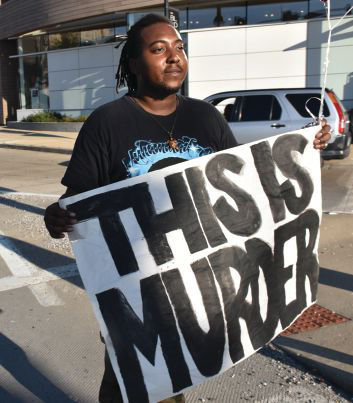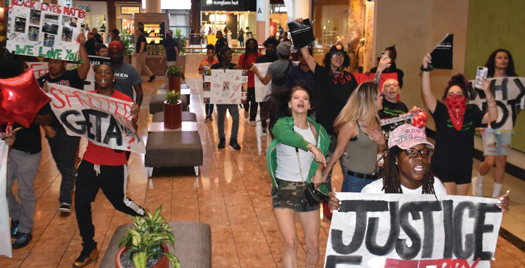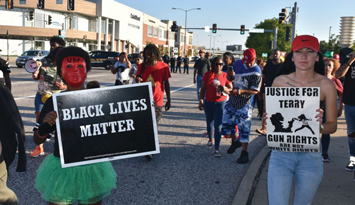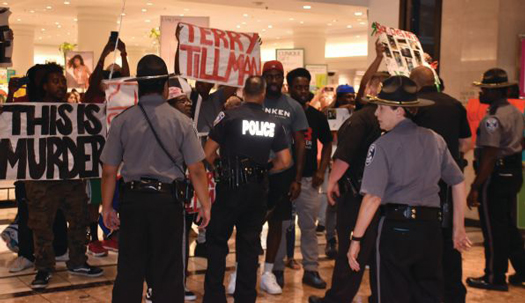A family seeks answers in a young man’s death
By J.A. Salaam -Contributing Writer- | Last updated: Sep 18, 2019 - 9:27:47 AMWhat's your opinion on this article?

Protests Galleria Mall outside St. Louis shut down traffic.
|
The press conference Sept. 13 came two weeks after a Richmond Heights police officer shot the young Black male to death. His family rejects the police story that he ran from a nearby mall after being approached by officers, then turned and pointed a weapon at police. The family doesn’t believe Mr. Tillman’s death was justified. Officials say he was shot seven times in the chest by a single officer.
Family members say they want the truth of what happened on Saturday, Aug. 31, at 3 p.m. in the parking lot of Simmons Bank near the Galleria Mall in Richmond Heights. The bank is across the street from the shopping mall where Mr. Tillman was first approached by police.
Authorities say a Richmond Heights officer saw an extended gun magazine hanging out of Mr. Tillman’s waistband while he was walking through the mall. Firearms are not allowed in the mall and police approached Mr. Tillman, who ran out of the mall to the bank parking lot, turned and pointed a weapon at police, said the authorities. Officers were chasing him and one officer opened fire, police said.
According to Mr. Tillman’s girlfriend, he met her to go shopping just moments before the encounter.
Racheal Jones, a sister of Mr. Tillman’s speaking for the family, said the family wanted to get past a Sept. 12 memorial service before pushing for answers. A private viewing of Tillman was held for family and friends. Many of his friends gathered by his casket crying and hugging during a two-hour service. Though Mr. Tillman grew up in a Black neighborhood, many of his friends were from predominantly White and Latino communities. He was well known for skateboarding and respected in the St. Louis region as an up and coming hip hop artist, web designer and entrepreneur, according to family and friends.
At the press conference, Mrs. Jones stood on a sidewalk in front of the Richmond Heights police department with family members and a few friends. “Our family is demanding for them to provide the name, the rank, and the picture of the man that killed my brother Terry Tillman. Our family is demanding to show and provide a copy of any and all footage of the shooting. Our family is demanding for anybody to show proof that he was pointing a gun,” she said. “Our family wants justice … we want the real story. We want the truth here because what they’re telling is not the truth.”
Despite reports of 158 hours of footage from the mall the day of the shooting, Mrs. Jones said her family has not received any footage from the authorities. “We’re giving y’all a time limit. We’re giving y’all one week and justice for Terry Tillman is what I’m going to say. We’re giving y’all one week … or else,” she said. She did not elaborate on what the “or else” would mean but protestors largely shutdown the mall during one demonstration and blocked traffic to bring attention to the case and demand justice.

Protestors disrupt business in the Galleria Mall in suburb of St. Louis.
|
A male reporter asked Mrs. Jones about being patient with the ongoing investigation during the press conference. “Do they say be patient anytime it’s any other killer? Why do we need to be patient right now? Because it’s a White police officer? Is this the way that they handle any other investigation?” Mrs. Jones responded.
“How do you respond to critics who are talking about his background, and why did he run?” asked another reporter. The St. Louis Post Dispatch reported Mr. Tillman was on probation after serving five years of a 10-year prison sentence for a 2013 robbery. Court records show there was a warrant out for his arrest in a theft case.
“They (police) didn’t know that. Did they know my brother’s background at the point of approaching him? The way they approached him?” she asked. “We live in St. Louis, Mo., where they’re shooting and killing Black men. But just like all these newscasts was first to blast my brother’s criminal history, I’m here to say that they didn’t know that when they chased him down and shot him down. They knew none of that.”

Protests Galleria Mall outside St. Louis demand justice for Terry Tillman.
|
“How about he was trying to run out the door and they still chased him? He wasn’t even on their property no more when they killed him. He wasn’t in the Galleria with a gun when they killed him. He was on the top of another parking lot with nowhere else to run, about to surrender when they shot him.” said Mrs. Jones.
In the Galleria Mall, which is privately owned, bringing a firearm or weapons is prohibited. “All they had to do was tell him to leave the mall, no matter if he walked, ran, jog, why chase him?” asked Mrs. Jones. “He was away from the mall, leave him alone.”
“They said he was not threatening no one, he was just trying to get away from them. Why were they chasing him, if he’s not under arrest?” she asked.
Missouri is an open carry state and firearms are allowed anywhere they are not prohibited. Local jurisdictions, however, can limit places where firearms are allowed. As of Jan, 1, 2017, anyone 19 or older can carry a concealed weapon without a permit and with no special firearms training. Conceal carry permits are available from local sheriffs, but require passing a firearms training course and background check.
Police said Mr. Tillman was a convicted felon and not allowed to carry a gun.
His sister says her brother didn’t commit a theft and was in the hospital when it allegedly happened. She also said there was no warrant out for his arrest.
“My brother was lost, my brother needed a hug, he needed a daddy. My brother needed someone in his head to tell him to settle down. And just when he was doing good, him and his girlfriend got an apartment, baby on the way … the police killed him,” she said.
The St. Louis American covered a dilemma that often arises between young Black males and police in a Sept. 5 editorial, “The police killing of Terry Tillman and the prisoners’ dilemma,” “So why did Tillman turn against the police officer and flee, rather than trust and cooperate? One of Tillman’s sisters, Racheal Jones, was asked this question during a vigil on Sunday. ‘You want to know why he ran?’ Jones responded. ‘Ask all of these young Black men.’

Demonstrators demand justice for Terry Tillman, a Black man shot by a police officer during protest at Galleria Mall in St. Louis suburb.
|
“Young Black men in St. Louis learn the hard way that, when a police officer approaches you, he is not likely to simply explain the policy he thinks you are violating and let you leave without further harassment. For example, though the police do not need to know your identity to inform you that the mall does not permit firearms, any young Black man in St. Louis stopped by a police officer assumes that, at the very least, he will be directed to provide identification. And, if Ferguson taught us nothing else, it taught us that there are nearly as many outstanding arrest warrants as people in this region,” the editorial noted.
“So, if Tillman had trusted the police officer to perform this one simple task, as (St. Louis County Police Sgt. Benjamin Granda) envisioned, but the police officer had gone further than explaining the mall policy and asked for identification and checked police databases, in fact he would have found an arrest warrant for Tillman. The police officer did not know this, but Tillman knew it. Also, the police officer did not know that Tillman had a felony on his record and so was committing a Class D felony by carrying the firearm he brought to the mall. Expecting the police officer would do more than explain a mall policy and politely ask Tillman to leave without asking for identification, Tillman decided he would try to outrun prison. That decision—and a police officer’s subsequent decision to shoot him—cost him his life.
“We will never know the disposition of the case for which Tillman was wanted when he was killed. But one can question the wisdom of a convicted felon committing a new felony and risking a return to prison by carrying a firearm. However, in an unsafe city like St. Louis, many people, not only young Black men, feel more protected when they carry firearms. The law that makes it a Class D felony for a felon to possess a firearm presents yet another dilemma for a young man like Tillman: obey the law and leave yourself unprotected, or arm yourself and risk returning to prison every time you see a police officer. It’s a law that seems almost designed to turn prison into a revolving door.
“If it’s fair to ask why Tillman ran—because he did not trust the police—it’s just as fair to ask why the police officer pursued him. By leaving the mall, Tillman had stopped violating the mall policy which reportedly was the police officer’s only concern in stopping Tillman. One might argue that the officer’s job had been made even easier by Tillman, who stopped breaking the mall policy before it was even explained to him.”
INSIDE STORIES AND REVIEWS
-
-
About Harriett ... and the Negro Hollywood Road Show
By Rabiah Muhammad, Guest Columnist » Full Story -
Skepticism greets Jay-Z, NFL talk of inspiring change
By Bryan 18X Crawford and Richard B. Muhammad The Final Call Newspaper @TheFinalCall » Full Story -
The painful problem of Black girls and suicide
By Charlene Muhammad -National Correspondent- » Full Story -
Exploitation of Innocence - Report: Perceptions, policies hurting Black girls
By Charlene Muhammad -National Correspondent- » Full Story -
Big Ballin: Big ideas fuel a father’s Big Baller Brand and brash business sense
By Bryan Crawford -Contributing Writer- » Full Story






 Click Here Stay Connected!
Click Here Stay Connected!








